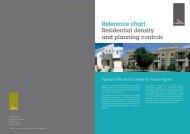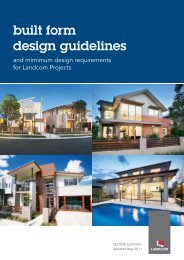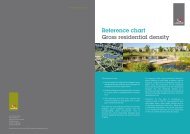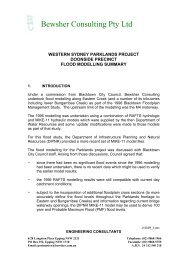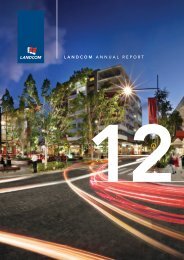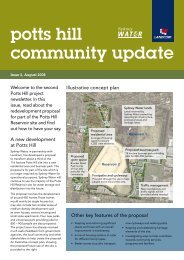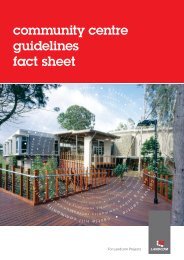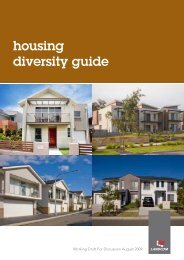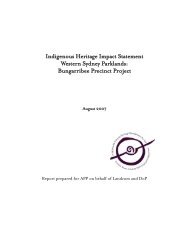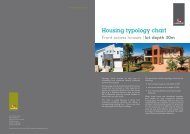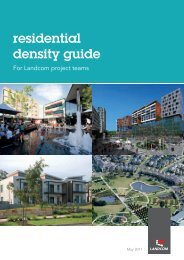WSUD Strategy
Parklands Bungarribee Precinct | WsUD Strategy Report - Landcom
Parklands Bungarribee Precinct | WsUD Strategy Report - Landcom
- No tags were found...
Create successful ePaper yourself
Turn your PDF publications into a flip-book with our unique Google optimized e-Paper software.
8 Conclusions<br />
This <strong>WSUD</strong> strategy outlines the objectives and corresponding opportunities for<br />
sustainable water management in the Bungarribee Creek Precinct of the Western Sydney<br />
Parklands. The strategy proposes an approach for stormwater pollution control, flow<br />
management and water conservation within the Bungarribee Precinct, as well as detailed<br />
water management options for the Sports Zone (Section 5), the Airstrip (Section 6), and the<br />
Recreation Hub, and Institutional Zone (Section 7).<br />
The Bungarribee Creek/Rooty Hill Precinct (Precinct 2) is the second of nine precincts that<br />
make up the Western Sydney Parklands. Eastern Creek flows through the centre of the<br />
precinct, joined by Bungarribee Creek from the east of the site. These creeks form part of<br />
the core habitat and riparian corridors within the Western Sydney Parklands. The core<br />
habitats areas include bushland remnants of the Cumberland Plain Woodland endangered<br />
ecological community. The preservation of the core habitats is assisted by the creation of<br />
the habitat corridors, forming critical ecological links throughout the Parklands. The<br />
conservation of these areas is integral to the vision of the Western Sydney Parklands.<br />
To complement the conservation areas of the Bungarribee Precinct there are significant<br />
areas of public open space to facilitate sport, physical development, economic activity,<br />
education, and recreation programs. The development areas within the Parklands will<br />
generate stormwater pollution as a result of increased impervious surfaces, traffic, and<br />
practices that result in a variety of pollutants entering the stormwater drainage system at<br />
elevated concentrations. With the increase in impervious areas associated with the<br />
proposed development, the volume and velocity of stormwater runoff will increase. Water<br />
quality treatment and attenuation of these increased flows is required to protect water<br />
quality, the geomorphic form of Eastern Creek, and to prevent worsened downstream<br />
flooding. The site occurs in an area of high salinity risk and precautions need to be taken<br />
to avoid exposing the sodic subsurface soils. Care must also be taken to prevent any<br />
increase in infiltration to the groundwater.<br />
Though management of the site may seem complex due to the multiplicity of land uses<br />
ranging from protected habitat to commercial areas, the site offers considerable<br />
opportunities for water management. The proximity of urban impervious surfaces and<br />
external catchments adjacent to an abundance of public open space facilitates stormwater<br />
harvesting and reuse. Runoff from paved or impervious surfaces can be captured and used<br />
to irrigate the public open spaces. Roof runoff can be captured in rain tanks, to supply<br />
water for the Park’s amenities. The local proximity of a wastewater treatment plant (7 km)<br />
provides an opportunity to reuse treated wastewater supplied through a reuse pipeline to<br />
meet the large irrigation requirements areas within the Precinct. These initiatives are likely<br />
to be less costly than traditional dependence on potable water supplies, have significant<br />
broader ecological benefits and will be well regarded by the public for whom the Parklands<br />
are intended to service.<br />
The <strong>WSUD</strong> strategy has been developed so as to form the basis of site specific strategies<br />
for developments within the Precinct, and set targets for stormwater pollution and flow<br />
control, and water conservation. The strategy is based on the water management<br />
principles and objectives of the state and local government and Landcom planning policies.<br />
These principles are designed to protect stream health and promote water conservation. The water<br />
management principles adopted for the Bungarribee Precinct are:<br />
• Stormwater runoff from development areas within the Parklands as well as from external<br />
catchments is to be treated to attain current best practice water quality standards.<br />
• Water conservation through demand management and the use of alternative sources of<br />
water to meet non potable demands.<br />
• Post-development storm discharges are to be controlled so as to mimic pre-development<br />
storm discharges up to the one and a half year ARI event. This will minimise the adverse<br />
impacts of frequent events on the natural waterways and minimise bed and bank erosion.<br />
• Post-development storm discharges up to the 100 year ARI event are to be managed so as<br />
to minimise the impact of flood events. Drainage and flooding issues need to be adequately<br />
addressed for the protection of people, property and the natural environment.<br />
• The health and biodiversity of the waterways, natural systems and vegetation is to be<br />
restored and protected.<br />
The application of these principles and targets to individual precincts within the broader Parklands<br />
will result in varying elements based on the specific opportunities and site constraints and reflect<br />
the activities proposed within that precinct. Detailed water management options have been<br />
developed for nominated areas within Bungarribee Precinct, including the Sports Zone (Section 5),<br />
the Airstrip (Section 6), and the Recreation Hub, and Institutional Zone (Section 7). As a separate<br />
component of this project, <strong>WSUD</strong> Strategies have been established for the Doonside Residential<br />
Parcel (Ecological Engineering, 2007) and the Huntingwood West Employment Zone (Ecological<br />
Engineering, 2006).<br />
The water management elements proposed for the Sports Zone address water quality, water<br />
conservation and management of the modifications to the hydrology. Bioretention systems improve<br />
the water quality of stormwater runoff from the impervious surfaces. Rainwater tanks, water efficient<br />
fixtures and stormwater harvesting will ensure conservation of potable water. The management of<br />
stormwater to maintain the hydrology to natural terrestrial landform is achieved through stormwater<br />
harvesting by managing flow paths at the interface with the Parklands and to Eastern Creek.<br />
The geomorphology of Bungarribee Creek is vulnerable to scouring and erosion resulting from<br />
existing urban flows from its large developed catchment. The proposed Airstrip Promenade<br />
development aims to enhance the ecological value of the area and to create a vibrant community<br />
space. This presents an opportunity to address threats to the waterway from its existing urban<br />
catchment through the interception, diversion and treatment of frequent events from the upstream<br />
catchment, so as to lessen their impact on the waterways, and to return the waterway hydrology<br />
closer to its pre-development state. The diversion and wetland are integrated with the vision for the<br />
Promenade.<br />
The Recreational Hub and Potential Institutional Precinct include a large event space, playground,<br />
native grasslands conservation area, and development related to tourism, educational and<br />
commercial recreation facilities. The existing drainage depression and ephemeral wetland area<br />
present opportunities for enhancement with integration of <strong>WSUD</strong> and landscaping opportunities.<br />
Car parking areas can be designed to significantly reduce the development impacts. Stormwater<br />
management measures tailored to the development would address both water quality and the<br />
hydrology from the developed catchment. Demand management and the use of alternative water<br />
sources to meet non-potable demands are both important elements for the water conservation<br />
strategy recommended for the precinct.<br />
Western Sydney Parklands, Bungarribee Precinct, <strong>WSUD</strong> <strong>Strategy</strong> June 2007 19



